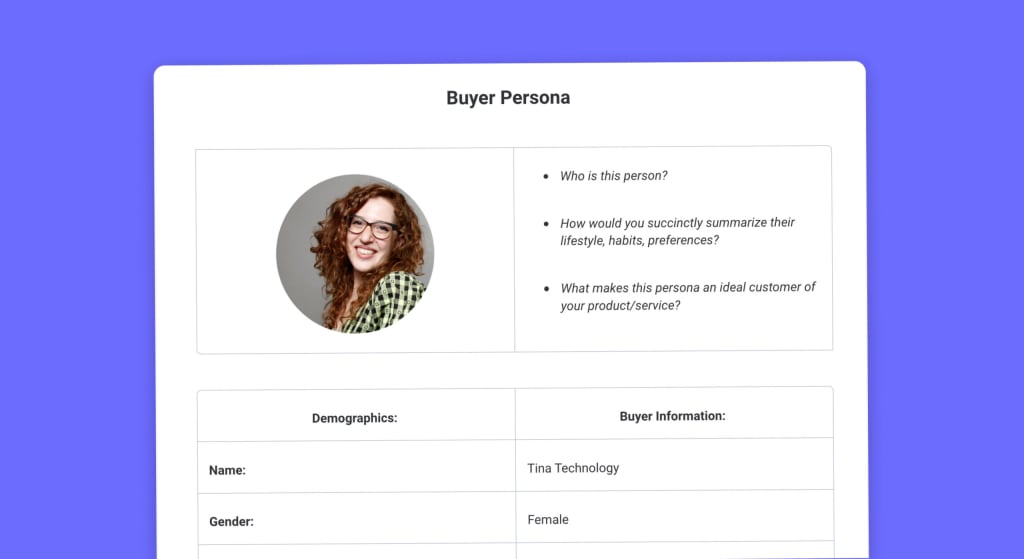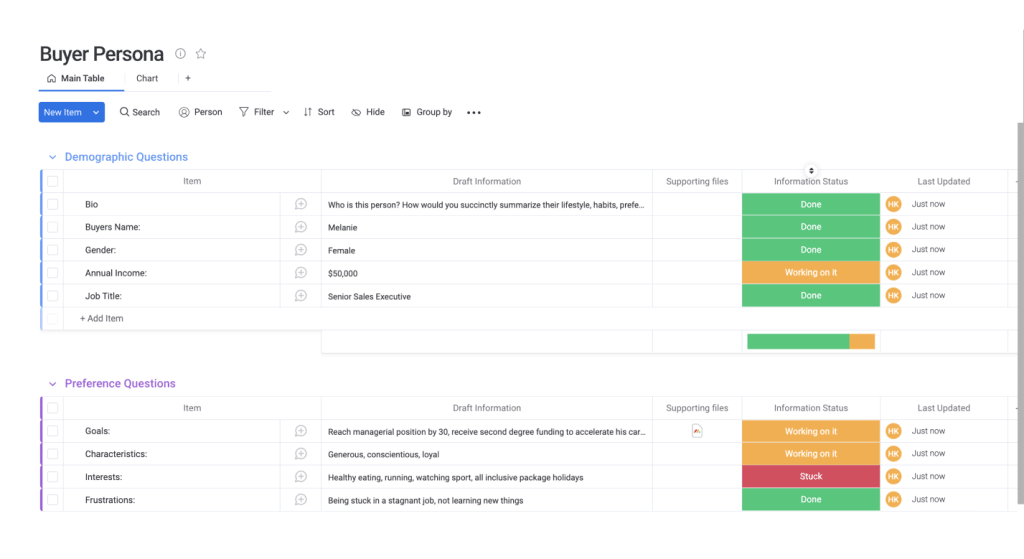In the next several minutes, you’ll discover how a positioning statement can help boost customer engagement in the digital marketing space. You’ll also receive a free, customizable positioning statement template to use within monday.com Work OS.
But before we go too deep into templates, let’s first ensure we understand what a positioning statement is all about.
What is a positioning statement template?
A positioning statement template is a short document that provides a concise description of your brand’s target market. It also specifies how you want the target buyers to perceive your company and products.
An effective positioning statement should have four parts: the target, the category, the differentiator, and the payoff. Don’t worry about nailing your brand’s voice in this document. A positioning statement template isn’t promotional material; it’s an internal tool that helps your company gain clarity about its brand and target market.
A positioning statement can help you identify how your brand differs from its competitors. Once you create a positioning statement, you have a reliable baseline for making decisions about your branding and marketing strategies. The positioning statement includes your brand’s value proposition to ideal consumers and outlines how your products and services can best serve customers.
This is where a template comes in. With a template, you can access all the relevant information in one place, creating a statement that truly reflects your brand.
How a positioning statement template can reduce your workload
Using a template to write your positioning statement can help you identify important aspects of your marketing objectives to better engage your target market.
A positioning statement template reduces the workload of developing a marketing strategy. Although it may seem overwhelming to make brand decisions for your company when starting to develop a marketing strategy, a template can make things significantly easier.
Following a template helps you create your positioning statement step by step, ensuring you don’t miss any of the key elements involved in writing this concise description.Now that we’ve gone over what a positioning statement is, you may find it helpful to see some examples of positioning statement templates.
There are several types of positioning statements
Depending on your company and target audience you may need a different positioning statement. For instance, you would use a different positioning statement template for a business-to-business (B2B) or business-to-consumer (B2C) than you would for a nonprofit. Let’s explore a few of these template examples below.
B2B and B2C positioning statement templates
B2B sales focuses on the logical processes and technical aspects of a product. Rather than appealing to the general public, this type of marketing must appeal to other brands within that industry. In contrast, a B2C positioning statement template helps you build a positioning statement that appeals to the public.
Typically, B2C sales relies on emotional appeals rather than the technical and logistical approach of B2B marketing. For example, if a benefit of your B2B brand is that you are environmentally friendly, including this in your positioning statement can help your team know how to differentiate you from competitors.
Both B2B and B2C positioning statement templates typically include four sections:
- Target – who your brand appeals to
- Category -a frame of reference for your marketplace
- Benefit -what promise are you making to your target audience
- Support points -proof that you can deliver
While the template is generally the same, the key difference between writing your statement for a B2B and B2C brand is in your differentiator or benefits section. This is where you’re making either a sensible appeal (for B2B) or an emotional appeal (B2C) to hook your target audience.
Nonprofit positioning statement templates
A nonprofit positioning statement template takes on a similar format, but the approach to filling out the content is different. Nonprofit organizations should think about positioning statements as describing their “reason for being.” You’ll still want to identify your target audience, but rather than focusing on your consumer base, it’s going to reflect who your organization helps. A basic outline for a nonprofit positioning statement template can look like this:
- Target – who you help
- Category -the core value of your organization and the work you do
- Benefit -what makes your organization unique compared to others in the field
- Support points -why your work matters or the impact you’re having on your target audience
Nonprofit organizations can use their positioning statements to develop appeals to the public or businesses to obtain funding for their causes. Using a free positioning statement template from monday.com can make the process easier.
Kickstart your marketing strategy with a positioning statement template from monday.com
Companies with a well-written positioning statement and consistent branding see an average of 10%-20% increase in revenue. A positioning statement template allows companies to develop a clear sense of who they’re targeting with their products and services by defining key branding aspects, like how your services differ from the competition. The positioning statement template removes uncertainty from the writing process by guiding you through the steps of describing your brand and its purpose to help you streamline your marketing processes.
Who our template is for
Our template is for busy marketing teams of all types and sizes that want to turn prospects into customers and customers into buyers. We help you ensure you’re thinking about how your brand’s niche appeals to consumers for better customer engagement and loyalty.
Key features of a high-quality positioning statement template
A good positioning statement template should prompt you to include the following details in your brand description:
- Brand name
- Target audience
- Category/industry
- Point of difference (i.e. the most, the best at, a leader in)
- End benefit (promise to the customer)
- Action (the moves your brand is making to deliver on its promises)
monday.com’s Work OS capabilities
monday.com Work OS provides all the necessary tools to collaborate on marketing projects on one digital, cloud-based space.
Marketing teams can create custom workflow applications to plan, run, and track the progress of their projects. Workflow automation on the monday.com Work OS reduces the chance of human error, and our software’s building blocks mean all users can customize their workspaces for specific projects.
Besides positioning statement templates, monday.com has several related marketing templates to help further increase your team’s efficiency and support higher productivity levels.
A few templates you can use alongside the positioning statement templates
Many businesses also find it useful to obtain templates for other marketing practices. Working from a template can reduce the time and money spent on engaging customers while improving conversions. While a positioning statement template serves several crucial purposes, it doesn’t fit every situation. Thankfully, several related templates can fulfill other marketing needs.
Competitors analysis template
A competitors analysis template acts as a framework for performing a competitor analysis. This type of analysis looks at a brand’s competition and assesses its target demographic, strengths, pricing, and approach to marketing. The purpose of the competitive analysis is to identify the strengths and weaknesses of your own brand in comparison to others in the same marketplace.
A competitors analysis template walks you through the process of identifying your top competitors and describing them and their offerings. Then, the template prompts you to look at their strengths and weaknesses in various areas compared to your brand’s performance. Once complete, it lets you apply the information obtained from this analysis to make changes to your marketing plans.
Content calendar template
A content calendar template is an internal tool a company uses to improve productivity by planning marketing and social media content well in advance. The content calendar template prompts the team to consider and commit to dates when content will be published and to specify which media platform it’s published to. A content calendar is also sometimes referred to as an editorial calendar.
Typically, the template uses a calendar format and color-coding to identify when product launches, social media campaigns, webinars, blog posts, email newsletters, or ebooks go live online. The calendar template helps marketing teams schedule, organize, and plan deadlines so everyone is on the same page.
A/B tests template
A/B testing is a marketing experiment where teams split their customers into two groups to test various campaign strategies and gauge their efficacy. By testing out two strategies simultaneously, the brand can determine which strategy performs best and choose which one it will ultimately launch for the general public.
A good A/B test template breaks down the experiments into sections, requiring you to input your hypothesis (the assumed outcome of the strategy), details of the marketing strategy, variations on the design, and the outcomes of the experiment. When completing the template, marketing teams can assess the method and results of the experiment on the A and B test subjects side by side.
FAQs about positioning statement templates
What is a positioning statement?
A positioning statement is a concise description of a brand’s niche in its marketplace. It defines who their target audience is, what marketplace they compete in, how they are different from their competitors, and the proof they have to back those claims. You can use positioning statements as a guideline for making branding decisions when developing marketing strategies.
What are the four elements of a positioning statement?
The four elements of a positioning statement, regardless of whether you’re a B2B, B2C, or nonprofit organization always include:
- The target audience
- The category/marketplace you compete in
- What differentiates your brand from others
- Proof of your value/support for your claims
How do you write a positioning statement?
To write a positioning statement, start with a positioning statement template. Then, determine what type of positioning statement you’re developing based on your brand (B2B, B2C, nonprofit, etc.). Use this information to assess your target audience, your category, and the value you offer consumers.
Nail your branding with a positioning statement template from monday.com
Developing a strong positioning statement for your brand may seem challenging. But with a carefully thought-out template, you can develop a polished positioning statement that helps you make smart branding decisions and achieve your goals.

